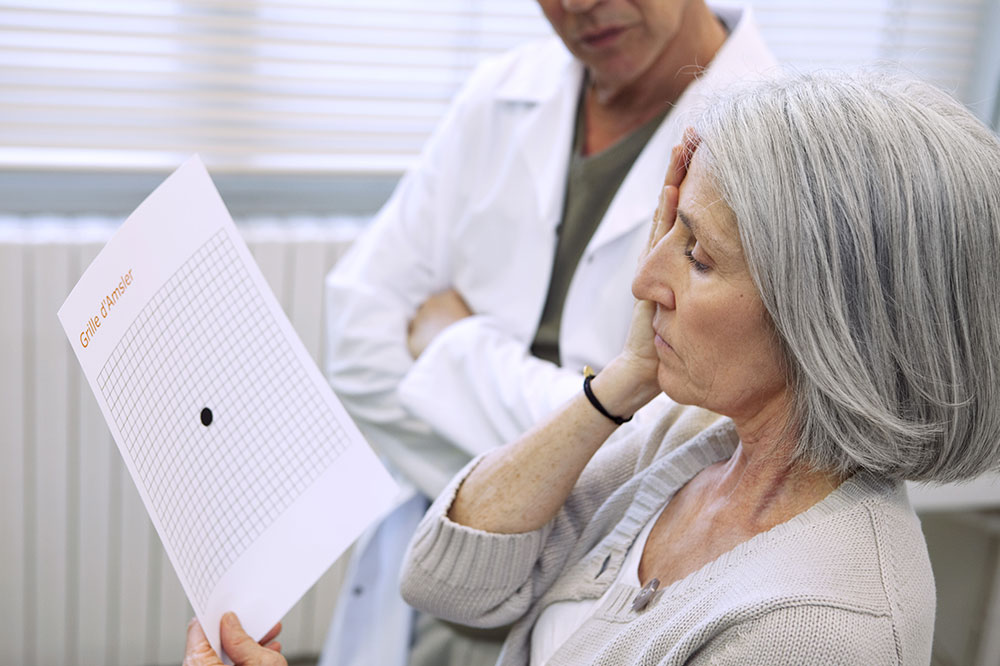
Macular degeneration – Types, causes, symptoms, and more
Age-related macular degeneration or AMD is a vision loss problem that develops in older men and women. AMD interferes with a person’s central vision, affecting their ability to see minute details. If the condition is left unchecked, it could lead to vision loss. There is no cure for macular degeneration. But it pays to be aware of the associated risk factors, types, and symptoms. Timely diagnosis can help slow down the progession of the condition.
Types of macular degeneration
There are two primary types of this vision problem.
Dry AMD
Dry age-related macular degeneration is more prevalent, diagnosed among nearly 85% to 95% of the total patients. It occurs when certain deposits called drusen accumulate behind the retina and obstruct vision. This damage is slow and progressive in nature, meaning the symptoms may take time to fully develop and affect central vision. AMD also develops in one eye at a time when the light-sensitive cells, known as photoreceptors, are unable to process the image on to the retina.
Wet AMD
Wet age-related macular degeneration is rare and affects no more than 10% to 15% of people diagnosed with this problem. However, it can lead to severe vision loss. In wet AMD, the blood vessels leak fluids behind the retina and distort normal vision. People develop blind spots that affects central vision. If the bleeding is not addressed in time, it can even result in permanent vision loss. Without running certain diagnostic tests, it becomes difficult to identify the AMD type. Ophthalmologists use an angiography or an Optical Coherence Tomography (OCT) to identify leaking of fluids or blood in the macula, a common symptom of wet AMD.
What causes macular degeneration?
While AMD remains one of the leading causes of vision loss, the exact trigger of this condition is not known. However, there are several known risk factors that increase the occurrence of this condition:
Old age
Advancing age is one of the main risk factors of AMD. Seniors over the age of 60 might experience some vision loss, although the risk is increased for seniors above the age of 80.
Gender
Women with AMD are at a high risk of severe vision loss in comparison to men.
Family history
People with a family history of age-related macular degenerations are at a high risk of experiencing central vision loss with advancing age.
Heath complications
High blood pressure and cardiovascular diseases increase the risk of AMD. Unhealthy eating and lifestyle choices also result in nutritional deficiencies that compromise immunity.
Symptoms of age-related macular degeneration
It is advisable to get a comprehensive eye checkup done if any of the symptoms given below develop:
Lines appear wavy
Tests like the Amsler Grid can confirm this symptom. If straight lines appear wavy or one has difficulty identifying common shapes, chances are central vision has been affected.
Blurry vision
Lines may appear distorted as the symptoms develop but it is also possible that some people experience increased blurry or fuzzy vision.
Blindspot
A definite blindspot in the central vision is a clear indicator of this condition. Immediate attention is required, especially for those diagnosed with wet AMD.
Foods for macular degeneration
Healthy changes in daily foods slow down the progression of the disease.
Fruits and vegetables
Fresh fruits and vegetables are rich in vitamins C, E, Beta carotene, and rich antioxidants that help counter cell damage. Broccoli, Brussels sprouts, kale, lettuce, and a variety of greens are excellent choices too. You must also have apricots, avocado, assorted berries, limes, lemon, papaya, grapes, and oranges.
Foods rich in omega 3s and healthy fats
Good fats, via assorted nuts and seeds, fatty fish, and olive oil, help maintain cholesterol levels and contain essential omega 3s that lower the risk of several associated health complications. A handful of almonds, walnuts, peanuts, pecans, chia seeds, and sunflower seeds can supplement these requirements.
Whole grains and legumes
Whole grains like oats, barley, rye, whole wheat, and millets are excellent sources of B vitamins, iron, magnesium, and fiber. Legumes including lentils, kidney beans, pinto beans, chickpeas, black eyed peas, and green peas additionally provide proteins and fiber.
Lifestyle changes for macular degeneration
There is no cure for macular degeneration. But it is possible to slow down the disease progression.
Regular exercise
Daily physical activity boosts immunity and lowers the risk of complications that can develop with macular degeneration. Consider light activities like walking, jogging, and cycling.
Avoid direct UV exposure
Wear sunglasses outside to avoid direct UV exposure. Proper eye protection lowers the risk of macular degeneration to some extent.




